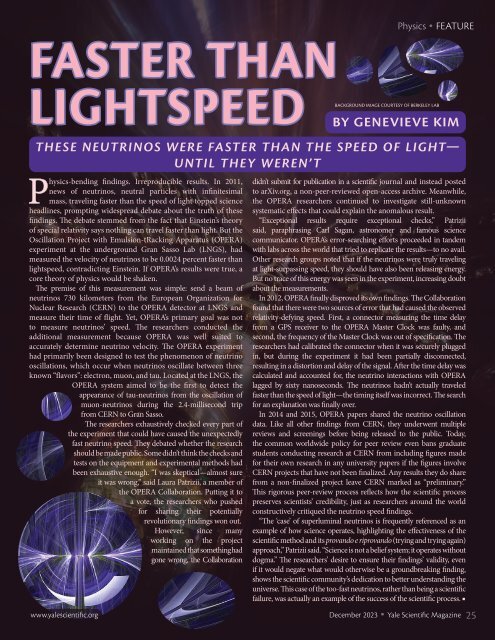YSM Issue 96.4
You also want an ePaper? Increase the reach of your titles
YUMPU automatically turns print PDFs into web optimized ePapers that Google loves.
FASTER THAN<br />
Physics<br />
FEATURE<br />
LIGHTSPEED<br />
THESE NEUTRINOS WERE FASTER THAN THE SPEED OF LIGHT—<br />
UNTIL THEY WEREN’T<br />
Physics-bending findings. Irreproducible results. In 2011,<br />
news of neutrinos, neutral particles with infinitesimal<br />
mass, traveling faster than the speed of light topped science<br />
headlines, prompting widespread debate about the truth of these<br />
findings. The debate stemmed from the fact that Einstein’s theory<br />
of special relativity says nothing can travel faster than light. But the<br />
Oscillation Project with Emulsion-tRacking Apparatus (OPERA)<br />
experiment at the underground Gran Sasso Lab (LNGS), had<br />
measured the velocity of neutrinos to be 0.0024 percent faster than<br />
lightspeed, contradicting Einstein. If OPERA’s results were true, a<br />
core theory of physics would be shaken.<br />
The premise of this measurement was simple: send a beam of<br />
neutrinos 730 kilometers from the European Organization for<br />
Nuclear Research (CERN) to the OPERA detector at LNGS and<br />
measure their time of flight. Yet, OPERA’s primary goal was not<br />
to measure neutrinos’ speed. The researchers conducted the<br />
additional measurement because OPERA was well suited to<br />
accurately determine neutrino velocity. The OPERA experiment<br />
had primarily been designed to test the phenomenon of neutrino<br />
oscillations, which occur when neutrinos oscillate between three<br />
known “flavors”: electron, muon, and tau. Located at the LNGS, the<br />
OPERA system aimed to be the first to detect the<br />
appearance of tau-neutrinos from the oscillation of<br />
muon-neutrinos during the 2.4-millisecond trip<br />
from CERN to Gran Sasso.<br />
The researchers exhaustively checked every part of<br />
the experiment that could have caused the unexpectedly<br />
fast neutrino speed. They debated whether the research<br />
should be made public. Some didn’t think the checks and<br />
tests on the equipment and experimental methods had<br />
been exhaustive enough. “I was skeptical—almost sure<br />
it was wrong,” said Laura Patrizii, a member of<br />
the OPERA Collaboration. Putting it to<br />
a vote, the researchers who pushed<br />
for sharing their potentially<br />
revolutionary findings won out.<br />
However, since many<br />
working on the project<br />
maintained that something had<br />
gone wrong, the Collaboration<br />
www.yalescientific.org<br />
BACKGROUND IMAGE COURTESY OF BERKELEY LAB<br />
BY GENEVIEVE KIM<br />
didn’t submit for publication in a scientific journal and instead posted<br />
to arXiv.org, a non-peer-reviewed open-access archive. Meanwhile,<br />
the OPERA researchers continued to investigate still-unknown<br />
systematic effects that could explain the anomalous result.<br />
“Exceptional results require exceptional checks,” Patrizii<br />
said, paraphrasing Carl Sagan, astronomer and famous science<br />
communicator. OPERA’s error-searching efforts proceeded in tandem<br />
with labs across the world that tried to replicate the results—to no avail.<br />
Other research groups noted that if the neutrinos were truly traveling<br />
at light-surpassing speed, they should have also been releasing energy.<br />
But no trace of this energy was seen in the experiment, increasing doubt<br />
about the measurements.<br />
In 2012, OPERA finally disproved its own findings. The Collaboration<br />
found that there were two sources of error that had caused the observed<br />
relativity-defying speed. First, a connector measuring the time delay<br />
from a GPS receiver to the OPERA Master Clock was faulty, and<br />
second, the frequency of the Master Clock was out of specification. The<br />
researchers had calibrated the connector when it was securely plugged<br />
in, but during the experiment it had been partially disconnected,<br />
resulting in a distortion and delay of the signal. After the time delay was<br />
calculated and accounted for, the neutrino interactions with OPERA<br />
lagged by sixty nanoseconds. The neutrinos hadn’t actually traveled<br />
faster than the speed of light—the timing itself was incorrect. The search<br />
for an explanation was finally over.<br />
In 2014 and 2015, OPERA papers shared the neutrino oscillation<br />
data. Like all other findings from CERN, they underwent multiple<br />
reviews and screenings before being released to the public. Today,<br />
the common worldwide policy for peer review even bans graduate<br />
students conducting research at CERN from including figures made<br />
for their own research in any university papers if the figures involve<br />
CERN projects that have not been finalized. Any results they do share<br />
from a non-finalized project leave CERN marked as “preliminary.”<br />
This rigorous peer-review process reflects how the scientific process<br />
preserves scientists’ credibility, just as researchers around the world<br />
constructively critiqued the neutrino speed findings.<br />
“The ‘case’ of superluminal neutrinos is frequently referenced as an<br />
example of how science operates, highlighting the effectiveness of the<br />
scientific method and its provando e riprovando (trying and trying again)<br />
approach,” Patrizii said. “Science is not a belief system; it operates without<br />
dogma.” The researchers’ desire to ensure their findings’ validity, even<br />
if it would negate what would otherwise be a groundbreaking finding,<br />
shows the scientific community’s dedication to better understanding the<br />
universe. This case of the too-fast neutrinos, rather than being a scientific<br />
failure, was actually an example of the success of the scientific process. ■<br />
December 2023 Yale Scientific Magazine 25

















